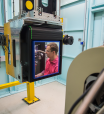Investigating the benefits of particle therapy in 2018 tour
AINSE study tour takes ANSTO and key stakeholders to Japan.

Showing 1481 - 1500 of 2192 results
AINSE study tour takes ANSTO and key stakeholders to Japan.

The High Performance Macromolecular Crystallography beamline will enable the study of very small (sub-5 micrometre) or weakly diffracting crystals, providing a state-of-the-art high-throughput facility for researchers. MX3 will be able to study the structures of large proteins and protein complexes for virology, drug design and industrial applications via goniometer mounted crystals, in-tray screening, or via serial crystallography methods.
Using PET and simulations to verify the accuracy of dose and range in advanced therapy with heavy ions
A team of researchers from ANSTO and University of Technology Sydney have set a record by conducting thin film experiments at 1100 degrees C.

Research to provide critical knowledge on groundwater residence times, important catchments and aquifers in order to ensure sustainable yields of groundwater resources.
Modelling and experimentation - a powerful combination in probing mechanical properties of ion irradiated materials through nanoindentation.
ANSTO has provided supporting experimental evidence of a highly unusual quantum state, a quantum spin liquid (QSL), in a two-dimensional material.
Dr Catalina Curceanu will explore exotic atoms and impossible phenomena in the universe.
Monash University, University of Queensland and Australian National University researchers have used ANSTO’s Australian Synchrotron in their study of meteorites found on Earth that could be used in future to find evidence of life on the planet Mars.
Research reveals that strong westerly winds weaken the Southern Ocean’s ability to store carbon and thereby contribute to faster accumulation of carbon dioxide in the atmosphere
New three year study with UNSW for Cotton Research Development Corporation.
Study shows for the first time that vegetation in the Windmill Islands, East Antarctica is changing rapidly in response to a drying climate.
A number of sophisticated non-invasive nuclear and accelerator techniques were used to provide information about the origin and age of an Australian Aboriginal knife held in the collection of the Powerhouse Museum.